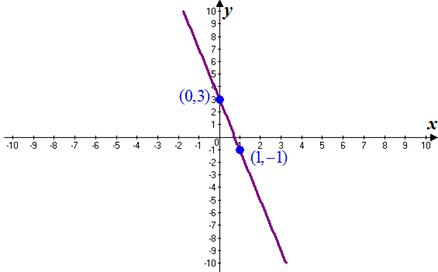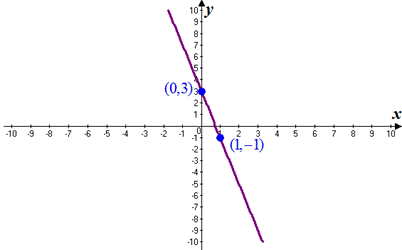
Concept explainers
(a)
To find: the slope and y -intercept
(a)
Answer to Problem 1CT
Slope
y -intercept
Explanation of Solution
Given:
f(x)=-4 x+3
Calculation:
Recall that the slope-intercept form of a line is
Where the slope of the line is
Compare the given function with the slope-intercept form.
Slope
y -intercept
Conclusion:
Therefore, the slope
(b)
To find: the average rate of change of f
(b)
Answer to Problem 1CT
The rate of change =-4
Explanation of Solution
Calculation:
For calculating average rate of change of given function, we need any two points for it. Also
-intercept is our one point and for second point
Let
So, the second coordinate in
Now as the rate of change
Here
So, the rate of change
Conclusion:
The rate of change =-4
(c)
whether f is increasing, decreasing, or constant.
(c)
Answer to Problem 1CT
Thus function is decreasing in the interval
Explanation of Solution
Calculation:
As the slope of the given function is -4 that is negative, that means it is decreasing function as if slope is negative that means its line makes an obtuse angle with positive side of
Thus function is decreasing in the interval
Conclusion:
Thus function is decreasing in the interval
(d)
To graph: the function f.
(d)
Answer to Problem 1CT

Explanation of Solution
Calculation:
Sketch the graph of line joining two points (0,3) and (1,-1) where (0.75,0) is the 
Conclusion:
Thus, the required graph is drawn.
Chapter 3 Solutions
Precalculus
Additional Math Textbook Solutions
Introductory Statistics
Elementary Statistics: Picturing the World (7th Edition)
University Calculus: Early Transcendentals (4th Edition)
Basic Business Statistics, Student Value Edition
Algebra and Trigonometry (6th Edition)
College Algebra (7th Edition)
- Let the region R be the area enclosed by the function f(x)= = 3x² and g(x) = 4x. If the region R is the base of a solid such that each cross section perpendicular to the x-axis is an isosceles right triangle with a leg in the region R, find the volume of the solid. You may use a calculator and round to the nearest thousandth. y 11 10 9 00 8 7 9 5 4 3 2 1 -1 -1 x 1 2arrow_forwardLet the region R be the area enclosed by the function f(x) = ex — 1, the horizontal line y = -4 and the vertical lines x = 0 and x = 3. Find the volume of the solid generated when the region R is revolved about the line y = -4. You may use a calculator and round to the nearest thousandth. 20 15 10 5 y I I I | I + -1.5 -1 -0.5 0.5 1 1.5 2 2.5 3 -5 I -10 -15 I + I I T I I + -20 I + -25 I I I -30 I 3.5 4 xarrow_forwardplease show all the workarrow_forward
 Calculus: Early TranscendentalsCalculusISBN:9781285741550Author:James StewartPublisher:Cengage Learning
Calculus: Early TranscendentalsCalculusISBN:9781285741550Author:James StewartPublisher:Cengage Learning Thomas' Calculus (14th Edition)CalculusISBN:9780134438986Author:Joel R. Hass, Christopher E. Heil, Maurice D. WeirPublisher:PEARSON
Thomas' Calculus (14th Edition)CalculusISBN:9780134438986Author:Joel R. Hass, Christopher E. Heil, Maurice D. WeirPublisher:PEARSON Calculus: Early Transcendentals (3rd Edition)CalculusISBN:9780134763644Author:William L. Briggs, Lyle Cochran, Bernard Gillett, Eric SchulzPublisher:PEARSON
Calculus: Early Transcendentals (3rd Edition)CalculusISBN:9780134763644Author:William L. Briggs, Lyle Cochran, Bernard Gillett, Eric SchulzPublisher:PEARSON Calculus: Early TranscendentalsCalculusISBN:9781319050740Author:Jon Rogawski, Colin Adams, Robert FranzosaPublisher:W. H. Freeman
Calculus: Early TranscendentalsCalculusISBN:9781319050740Author:Jon Rogawski, Colin Adams, Robert FranzosaPublisher:W. H. Freeman
 Calculus: Early Transcendental FunctionsCalculusISBN:9781337552516Author:Ron Larson, Bruce H. EdwardsPublisher:Cengage Learning
Calculus: Early Transcendental FunctionsCalculusISBN:9781337552516Author:Ron Larson, Bruce H. EdwardsPublisher:Cengage Learning





